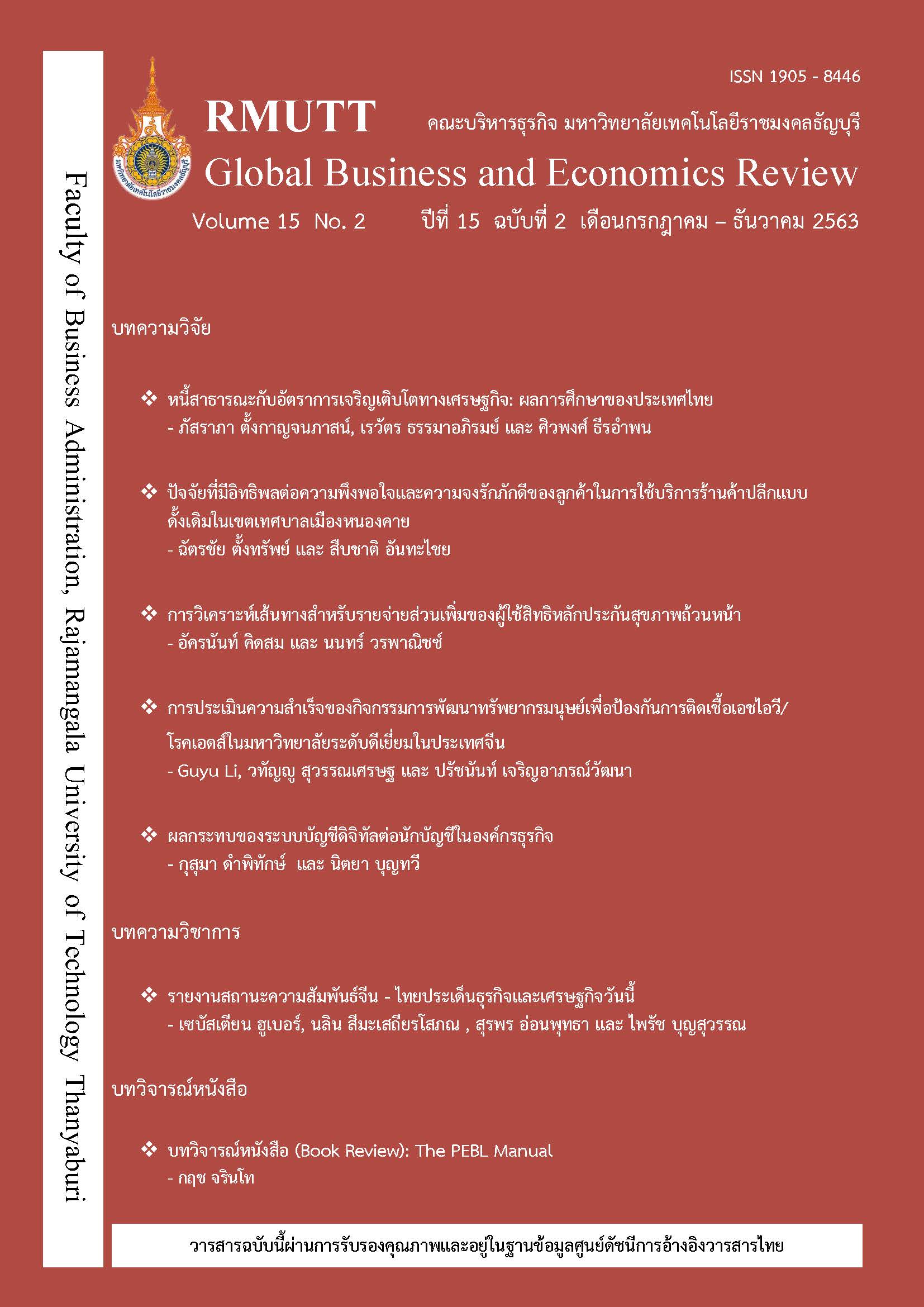PUBLIC DEBT AND ECONOMIC GROWTH : THE EMPIRICAL RESULT OF THAILAND
Keywords:
Debt Public, Economic Growth, Turning PointAbstract
This paper aims to study the effect of public debt to economic growth in Thailand using Two Stage Least Square estimators (2SLS). This study uses of time series quarterly data from 1998 to 2017. The regression results conclude that the relationship between public debt to GDP ratio and economic growth is non-linear and negative. The relationship between public to GDP ratio and economic growth is positive. The relationship between public to the square of GDP ratio and economic growth is negative. The highest turning point is at 48 Percent an inverted U-shaped. If debt exceeds this point, the relationship between GDP growth and public debt will change from positive to negative relationship.
References
Ali Abbas, S. A. & Christensen, J. E. (2007). The role of domestic debt markets in economic growth: an empirical investigation for low-income countries and emerging markets. Washington, D.C.: International Monetary Fund.
Baum, A., Checherita-Westpha, C., & Rother, P. (2012). Debt and growth new evidence for the Euro area. Germany: European Central Bank.
Bilan, I., & Ihnatov, I. (2015). Public debt and economic growth: a two-sided story. International Journal of Economic Sciences, 4(2), 24-39., DOI: 10.20472/ES.2015.4.2.003
Blassone, F., Francese, M., & Pace, A. (2011). Public debt and economic growth in Italy, Quaderni di storia economica (Economic History Working Papers) 11. Italy: Bank of Italy, Economic Research and International Relations Area.
Caner, M., Grennes, T., & Koechler-Geib, F. (2010). Finding the tipping point: when sovereign debt turns bad. In Braga, C. & Vincelette, G. (Eds), Sovereign Debt and the Financial Crisis: Will this Time be Different?. Washington, D.C.: World Bank.
Checherita-Westphal, C., & Rother, P. (2010). The impact of high and growing government Debt on economic growth: an empirical investigation for the euro area. European Central Bank Working Paper, No.1327. Retrieved from https://ideas.repec.org/p/ecb/ecbwps/20101237.html
Checherita-Westphal, C., & Rother, P. (2012). The impact of high and growing government debt on economic growth: an empirical investigation for the euro area. European Economic Review, 56(7), 1392 – 1405.
Clements, B., Bhattacharya, R., & Nguyen, T. Q. (2003). External debt, public investment and growth in low-income countries. Washington, D.C.: International Monetary Fund.
Dinca, G., & Dinca, M. S. (2015). Public debt and economic growth in the EU post-communist countries. Journal for Economic Forecasting, 0(2), 119-132.
Ferreira, C. (2009). Public debt and economic growth: a Granger causality panel data approach. Retrieved from https://www.researchgate.net/publication/254424952_Public_Debt_and_Economic_Growth_a_Granger_Causality_Panel_Data_Approach
Greenidge, K., Craigwell, R., Chrystol, T., & Drakes, L. (2012). Threshold effects of sovereign debt: evidence from the Carribean. Working Paper No.157. Washington, D.C.: International Monetary Fund.
Greiner, A. (2012). Debt and growth: is there a non-monotonic relation?. Economics Bulletin, 33(1), 340-347.
Hepp, R. (2008). Can debt relief buy growth?. department of economics. Retrieved from http://www.fordham.edu/images/academics/graduate_schools/gsas/economics/dp2008_22_hepp.pdf.
Herndon, T., Ash, M., & Pollin, R. (2013). Does high public debt consistently stifle economic growth? a critique of Reinhart and Rogoff. University of Massachusetts, working Paper Series No. 322. Amherst MA: Political Economy Research Institute.
Karagol, E. (2002). The causality analysis of external debt service and GNP: the case of Turkey. Central Bank Review, Research and Monetary Policy Department, Central Bank of the Republic of Turkey, 2(1), 39-64.
Krugman, P. (2010). Reinhart and Rogoff are confusing me. Retrieved form https://krugman.blogs.nytimes.com/2010/08/11/reinhart-and-rogoff-are-confusing-me/
Kumar, M. S., & Woo, J. (2010). Public debt and growth. Working Paper No.174. Washington, D.C.: International Monetary Fund.
Misztal, P. (2010). Public Debt and economic growth in the European Union. Journal of Applied Economic Sciences, 5(3), 292-302.
Moore, W., & Chrystol, T. (2010). A meta-analysis of the relationship between debt and growth. International Journal of Development Issues, 9(3), 214 – 225.
Mupunga, N., & Roux, P. le. (2015). Estimating the optimal growth-maximising public debt threshold for Zimbabwe. Southern Africa Business Review, 19(3), 102-128.
Nagler, J. (1999). Note on simultaneous equations and two state least squares estimates. Retrieved from http://www.nyu.edu/classes/nagler/quant2/notes/2slsnotes_oh.pdf
Panizza, U. & Presbitero, A. F. (2014, September). Public and economic growth: Is there Causal effect?, Journal of Macroeconomics, 41, 21-41.
Pattillo, C., Poirson H., & Ricci, L. (2002). External debt and growth. Working Paper No.69. Washington, D. C.: International Monetary Fund.
Pattillo, C., Poirson H., & Ricci, L. (2004). What are the channels through which external debt affects growth?. Working Paper No.15. Washington, D. C.: International Monetary Fund.
Pescatori, A., Sandri, D., & Simon, J. (2014). Debt and growth: is there a magic threshold?. Working Paper No.34. Washington, D. C.: International Monetary Fund.
Presbitero, A. F. (2010). The Debt-growth Nexus in Jamaica. Rome. Italy: Università Politecnica delle Marche. Public Debt Management Office. (2019). Data of Public debt. Retrieved from https://www.pdmo.go.th/th/public-debt/debt-outstanding.
Reinhart, C. M., & Rogoff, K. S. (2010a). Growth in a time of debt. American Economic Review, 100(2), 573 – 578.
Reinhart, C. M., & Rogoff, K. S. (2010b). Debt and growth revisited. Germany: Munich University.
Sachs, I. (1989). The debt overhang of developing countries, In Ronald, F., Debt, Stabilization and Development: Essays in Memory of Carlos F. Diaz-Alejundro. Oxford: Blackwell.
Schclarek, A. (2004). Debt and economic growth in developing and industrial countries. Sweden: Department of Economics, School of Economics and Management, Laud University.
Scott, G. (1995). Foreign debt service and economic growth. Atlantic Economic Journal, 23(2).
Smyth, D. J., & Hsing, Y. (1995). In search of an optimal debt ratio for economic growth. Contemporary Economic Policy, 13(4), 51 – 59.
Weeks, J. (2000). Latin America and high performing Asian economics: growth and debt. Journal of International Department, 12(5), 625-654.
Downloads
Published
How to Cite
Issue
Section
License
The articles published in this journal are the intellectual property of their respective authors.
The views and opinions expressed in each article are solely those of the individual authors and do not reflect the positions of Rajamangala University of Technology Thanyaburi or any of its faculty members. All components and content of each article are the sole responsibility of the respective authors. In the event of any errors, the authors shall bear full responsibility for their own work.








